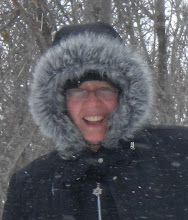.JPG)
.JPG)
.JPG)
In February, we went to a Potlatch in the village. It’s a night of native dancing. Kind of like a Hawaiian luau, but indoors and without the food. The thing ran two nights, and each night was about 8 hours long. It went from 6:00 in the evening until about 2:00 the following morning. We left about 11:00 both nights. (I know—pathetic; we just couldn’t stick it out.) It was actually pretty fun—especially since we know so many of the people who were performing.
People come from neighboring villages, and it's a big party. Each village holds two Potlatches every winter. They don’t have any after the thaw, because it is a busy time until the next freeze. During the summer and autumn, they are fishing (they actually go to fish camps where they stay and catch fish and prepare the meat, etc.), they are hunting and preparing meat and skins, and they are gather berries. So they don’t have time for celebrations. Besides—during the winter, it is much easier to travel to other villages for the Potlatches because the rivers are frozen over, and they can use snow machines to get around. And the Potlatches help break up the monotony of the long winter. They practice for several weeks beforehand. Just a couple of weeks after the one in February, they began practicing for the next one.
It's a big deal when a child performs at their first Potlatch. It's like a debutante dance, or a Spanish quinceaῆera, except it's for boys and girls. The child and his/her parents make special matching costumes, and they have special dances that they do together. The family brings a LOT of gifts for people who come. It is a very expensive event. At the one that we went to, I was given some warm knit gloves and a cool crocheted potholder. Keri was given a hat with ear pieces and some socks. Taco was given candy. And we were given sodas and cups of water. You multiply that by 200 to 300 people, and that is a lot of gifts being handed out. There were also some very expensive gifts that were given to the elders—like tools, torches, spears, stuff for ice fishing, etc.
After the child’s first Potlatch, when they have been presented to the village, then they are able to dance in any Potlatch. It was fun to watch our friends and their children.
The dancers move their body and use a handheld feather thing. Drummers chant and beat a type of drum made of a covering over a giant wooden ring. Each dance is quite short, usually only lasting a couple of minutes but the dancers repeat the dance as long as someone in the audience yells “more” or “again” in Yup’ik. (I can’t remember the words.) Most of the time, they are up there doing the same dance for about 20 minutes or so, but on some of the dances, the dancers repeated it for over 45 minutes. They looked exhausted.
The pictures show: part of the parking lot at the Potlatch (nothing but ATVs and snow machines). In the group shot, it shows my friend Stephanie and her daughter (in dark purple, and Stephanie wears glasses and has her hair piled on top of her head); her husband is kneeling on the ground with their son (also in purple, and her husband has glasses). It is their son and daughter’s first Potlatch. The other group picture shows Stephanie and her daughter (both in pink) dancing the second night.
I took some videos of it, because Stephanie’s camera broke and they didn’t have any pictures of their kids’ first Potlatch. That would be like not getting pictures of a high school graduation. But it was too big to e-mail, so I put it on YouTube. If you want to see some, just pull up YouTube.com. Then put AlaskaGirl8 in the search bar at the top, and it will bring up my Potlatch videos. There are seven of them, and they are all short.

No comments:
Post a Comment